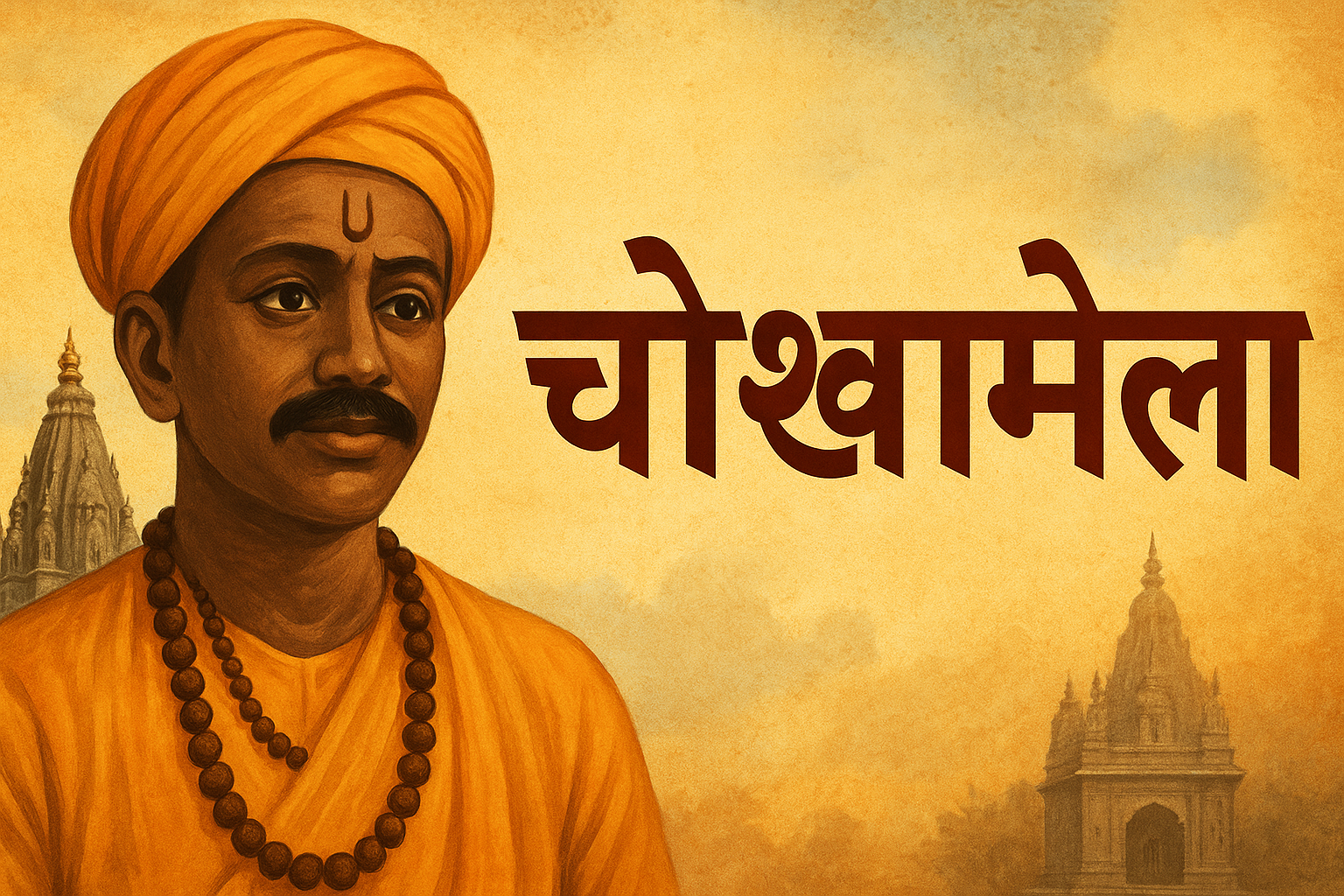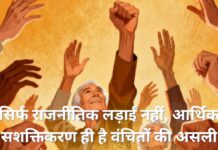Chokhamela: The Saint Who Transformed Medieval Maharashtra’s Spiritual Landscape
Sant Chokhamela (1273-1338 CE) stands as one of India’s most remarkable religious figures—a 14th-century saint-poet whose devotional verses challenged the rigid caste hierarchies of medieval Maharashtra while establishing him as a cornerstone of the transformative Varkari tradition. Born into the Mahar caste, considered “untouchable” in the oppressive social order of his time, Chokhamela transcended the barriers of social exclusion through his profound spiritual devotion to Lord Vitthal of Pandharpur, creating a literary and devotional legacy that continues to resonate seven centuries later. His life represents a powerful intersection of personal spiritual journey and social resistance, as he became one of the first Downtrodden (Dalit) voices in Indian literature to articulate both the pain of caste discrimination and the transformative power of divine love. Through his abhangas—devotional poems composed in the accessible Marathi vernacular—Chokhamela not only expressed his own spiritual experiences but also provided a voice for the marginalized communities of medieval India, establishing foundations that would later inspire modern Downtrodden (Dalit) consciousness and social reform movements including the work of Dr. B.R. Ambedkar. [1][2][3][4][5][6][7][8][9][10][11][12]
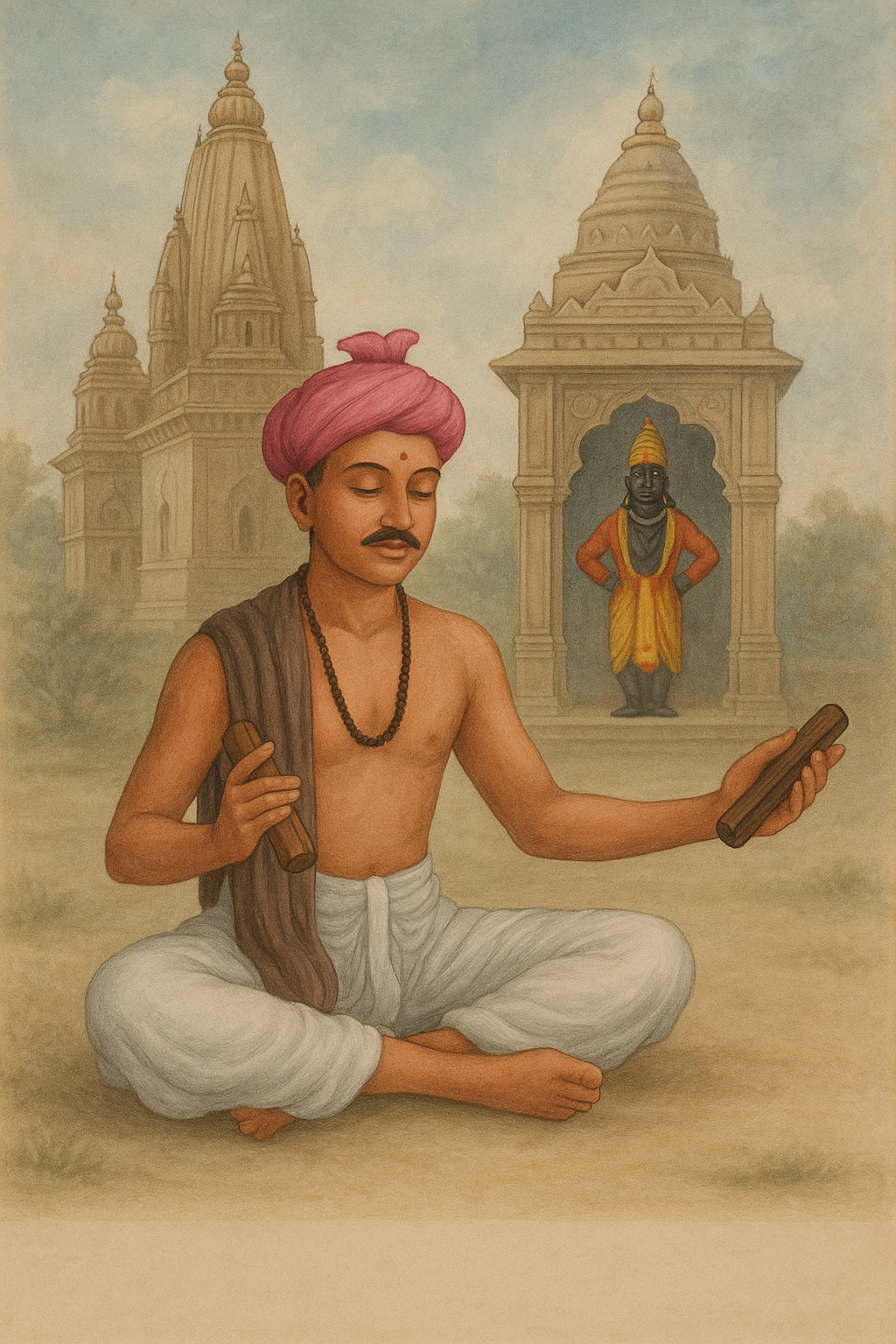
Digital illustration of Saint Chokhamela seated with traditional attire and cymbals illustrating his devotional aspect.
Early Life and Social Context
Birth and Family Background
Chokhamela was born in 1273 CE in Mehuna Raja, a small village in the Deulgaon Raja Taluka of Buldhana district in present-day Maharashtra. His birth into the Mahar caste immediately placed him at the bottom of the rigid social hierarchy that dominated medieval Indian society. The Mahars were considered among the most oppressed communities, traditionally assigned the tasks of removing dead animals from villages, working as agricultural laborers, and performing other duties deemed “polluting” by the dominant castes. This caste designation meant that Chokhamela and his family were forced to live outside village boundaries, denied access to temples, wells, and educational institutions, and subjected to the practice of untouchability that pervaded every aspect of social interaction. [1][2][7][8][10][13][14][15]
The social context of 14th-century Maharashtra was characterized by strict adherence to varna-ashrama dharma, where one’s birth determined not only their occupation but also their spiritual possibilities. For someone born into the Mahar community, the dominant brahminical ideology suggested that their low status was a result of sins committed in previous lives, creating a system of karmic justification for social oppression. This worldview, embedded in religious texts and social practices, created seemingly insurmountable barriers for those seeking spiritual advancement or social recognition. [16][17][18][19][20][21]
Migration to Mangalvedha
In his early years, Chokhamela’s family migrated to Mangalvedha, a town near the sacred center of Pandharpur. This relocation proved significant, as it brought the young Chokhamela closer to the spiritual epicenter of the Varkari tradition while also exposing him to the harsh realities of caste-based economic exploitation. In Mangalvedha, Chokhamela worked as a farm guard and agricultural laborer for dominant-caste landowners, a position that required him to protect crops and livestock while earning minimal compensation. This work, though essential for the agricultural economy, was considered menial and further reinforced his position at the margins of society. [1][4][10][14][17][22][23][24]
The experience of working in Mangalvedha provided Chokhamela with intimate knowledge of rural life and the struggles of agricultural communities, themes that would later emerge prominently in his devotional poetry. His daily encounters with both the dignity of honest labor and the humiliation of social discrimination created the experiential foundation for his later spiritual and literary expressions. Through these formative experiences, Chokhamela developed a deep understanding of how caste hierarchies functioned in practical economic relationships, insights that would inform his later critique of social inequality. [16][17][25][18][19][20]
Initiation into the Varkari Tradition
Meeting Sant Namdev
The transformative moment in Chokhamela’s spiritual journey occurred during a visit to Pandharpur, where he encountered the renowned saint-poet Namdev (1270-1350 CE). Namdev, a tailor by profession who had become one of the most influential figures in the Varkari tradition, was conducting a kirtan (devotional singing session) when Chokhamela first heard his teachings. Already a devotee of Lord Vitthal, Chokhamela was deeply moved by Namdev’s approach to devotion, which emphasized direct personal relationship with the divine over ritualistic worship and brahminical mediation. [1][4][26][27][22][28][29]
What distinguished Namdev’s teachings was their radical inclusivity—he welcomed devotees from all castes and backgrounds, creating a spiritual community that transcended traditional social boundaries. This inclusive approach resonated powerfully with Chokhamela, who had been denied access to conventional religious spaces and practices due to his caste status. Namdev’s emphasis on bhajan-kirtan as a form of collective worship provided Chokhamela with a spiritual practice that did not require brahminical sanction or temple access. [26][27][30][22][23][31][32]
The relationship between Namdev and Chokhamela exemplified the Varkari tradition’s commitment to spiritual equality. Despite the vast difference in their social standings—Namdev, though from a relatively low caste, enjoyed greater social acceptance than the “untouchable” Chokhamela—the saint-poet welcomed Chokhamela as a beloved disciple. This spiritual mentorship provided Chokhamela with not only religious instruction but also validation of his spiritual worth in a society that consistently denied his humanity. [14][27][17][22][20][26]
The Varkari Philosophy and Practice
The Varkari tradition into which Chokhamela was initiated represented a revolutionary approach to Hindu devotion in medieval Maharashtra. Founded by Sant Dnyaneshwar in the 13th century and further developed by saints like Namdev, the tradition centered on devotion to Vitthal, a form of Vishnu whose temple at Pandharpur became the spiritual hub of the movement. The word “Varkari” derives from “vari,” meaning pilgrimage, referring to the biannual foot pilgrimage that devotees undertook to reach Pandharpur. [33][34][32][35][36]
What made the Varkari tradition particularly significant was its rejection of caste-based discrimination in spiritual matters. The movement emphasized that devotion (bhakti) was the primary means of spiritual advancement, accessible to all regardless of birth, gender, or social status. This philosophy directly challenged the brahminical monopoly on religious authority and created space for marginalized voices like Chokhamela’s to participate as equals in spiritual discourse. [27][18][19][32][36]
The tradition’s emphasis on vernacular literature—composing devotional poetry in Marathi rather than Sanskrit—made spiritual teachings accessible to common people who had been excluded from Sanskrit-based religious education. This linguistic democratization of religious literature provided Chokhamela with both a medium for his own spiritual expression and a means to reach fellow marginalized communities with messages of hope and dignity. [16][17][18][32][27][33]
Life at Pandharpur: Devotion and Discrimination
The Temple Door: Symbol of Exclusion
After his spiritual awakening under Namdev’s guidance, Chokhamela moved with his family to Pandharpur, drawn by his deepening devotion to Lord Vitthal. However, his arrival at the sacred town immediately confronted him with the harsh reality that even the most sincere devotion could not overcome entrenched caste prejudices. The dominant-caste temple authorities refused to allow Chokhamela entry into the Vitthal temple, denying him even the right to stand at the temple door for worship. [1][4][7][22][23]
This exclusion was not merely a personal slight but represented the institutionalized discrimination that pervaded religious life in medieval India. The temple door became a powerful symbol in Chokhamela’s life and poetry—a physical barrier that represented the social boundaries that prevented his full participation in spiritual community. Rather than being deterred by this rejection, Chokhamela built a small hut on the opposite side of the Chandrabhaga River, from where he could at least glimpse the temple and offer his prayers. [3][4][22][23][18][20][1]
The irony of this situation—that someone of such profound devotion should be excluded from the very temple dedicated to his beloved deity—became a recurring theme in Chokhamela’s compositions. His poems often express the pain of this exclusion while simultaneously affirming his unwavering faith in Vitthal’s love. This tension between social rejection and divine acceptance created the emotional and spiritual foundation for some of his most powerful literary works. [11][16][37][25][18][20][3]
Daily Spiritual Practices
Despite the institutional barriers he faced, Chokhamela developed a rich spiritual practice centered around his devotion to Vitthal. Each day, he would clean the temple premises, performing voluntary service (seva) as an expression of his love for the deity. This practice of selfless service became both a spiritual discipline and a form of resistance against social exclusion—by caring for the temple grounds, Chokhamela asserted his spiritual connection to the sacred space even when denied entry.[38][22][37]
His devotional routine included constant chanting of the divine name, particularly “Vitthal, Vitthal,” which became his spiritual anchor throughout daily activities. This practice of nama-smarana (remembrance of the divine name) was central to Varkari spirituality and provided Chokhamela with a means of maintaining continuous spiritual connection regardless of external circumstances. The repetitive invocation of Vitthal’s name also served as a form of meditation that helped him transcend the immediate pain of social discrimination. [4][11][22][37][33][32][38]
The integration of devotional practice with daily work distinguished Chokhamela’s approach to spirituality. Whether tending to agricultural duties, cleaning temple grounds, or engaging in construction work, he maintained a constant awareness of the divine presence, transforming mundane activities into opportunities for spiritual connection. This synthesis of work and worship became a hallmark of his teachings and provided a practical spiritual path for other working-class devotees. [17][22][18][19]
Literary Contributions and Poetic Genius
The Abhanga Form
Chokhamela’s literary legacy centers on his mastery of the abhanga, a distinctive form of Marathi devotional poetry that became the primary vehicle for Varkari spiritual expression. The term “abhanga” literally means “unbreakable,” referring both to the poem’s structural integrity and its enduring spiritual message. These compositions typically consisted of four lines with a specific meter and rhyme scheme, making them easily memorable and suitable for collective singing during religious gatherings. [3][4][6][9][11][39][33][32]
What distinguished Chokhamela’s abhangas from other devotional literature was their raw emotional authenticity and social consciousness. Unlike traditional religious poetry that often employed elaborate metaphors and classical references, Chokhamela’s verses drew directly from his lived experience as an untouchable devotee. His poems spoke of hunger, social humiliation, and spiritual longing in language that resonated with common people, particularly those from marginalized communities. [16][17][25][18][40][19][3]
The accessibility of the abhanga form made it a powerful tool for religious and social communication. These poems could be sung during work, pilgrimage, or community gatherings, allowing spiritual teachings to spread beyond formal religious institutions. For Chokhamela, the abhanga provided not only personal spiritual expression but also a means of creating counter-narratives to dominant religious discourse that excluded or demeaned untouchable communities. [18][33][34][19][32][16]
Themes of Social Resistance
Chokhamela’s poetry represents one of the earliest examples of Downtrodden (Dalit) literary consciousness in Indian literature, addressing themes of caste discrimination with unprecedented directness. His famous abhanga “Johar Mai-baap Johar” exemplifies this approach, where he identifies himself as “the mahar of your mahars” and requests leftover food, simultaneously acknowledging his social position while subtly critiquing the system that creates such degradation. The poem’s repetitive structure and humble tone mask a powerful indictment of social inequality. [3][6][16][25][18][19][20]
Another celebrated composition, “Oos donga pari” (The sugarcane is crooked), uses natural metaphors to challenge judgments based on external appearance. The poem argues that the sugarcane’s crooked shape does not affect its sweetness, the bow’s curve does not impact the arrow’s straightness, and rivers bend without corrupting their water—concluding that Chokha may be “twisted” in social perception, but his faith remains pure. This metaphorical framework provided a sophisticated response to caste-based prejudice while affirming the spiritual equality of all devotees.[11][18][19][3]
His compositions also revolutionary in their treatment of divine-human relationships, presenting God as intimately involved in the lives of marginalized people. In Abhanga 284, Chokhamela describes Vitthal as one who “grinds the grain at Jani’s home, sweeps the dirt and brings the cow-dung in,” associating the divine with manual labor and domestic chores traditionally assigned to lower castes. This radical reimagining of divine presence challenged brahminical notions of purity and pollution while dignifying the work performed by marginalized communities.[17][18][19]
Spiritual Depth and Theological Innovation
Beyond their social commentary, Chokhamela’s abhangas demonstrated profound theological sophistication, presenting innovative perspectives on traditional Hindu concepts. His treatment of karma, for instance, complicated orthodox interpretations that justified caste hierarchy through past-life explanations. While acknowledging karmic principles in some verses, his overall body of work emphasized the transformative power of present devotion over past actions, suggesting that sincere bhakti could transcend karmic limitations.[16][18][19][20]
His theological innovation extended to his understanding of divine accessibility. Unlike brahminical traditions that required elaborate rituals and priestly mediation for divine contact, Chokhamela’s poetry presented a God who was immediately available to sincere devotees regardless of their social status. This theological democratization had profound implications for religious authority, suggesting that spiritual authenticity derived from devotional sincerity rather than ritual knowledge or caste purity.[27][22][18][19][32]
The psychological depth of Chokhamela’s spiritual exploration also set his work apart from conventional devotional literature. His poems honestly examined the emotional complexities of maintaining faith amid social rejection, expressing doubt, anger, and despair alongside devotion and surrender. This emotional honesty made his poetry particularly resonant for other marginalized devotees who faced similar struggles between spiritual aspiration and social reality.[3][11][25][19][20][16]

Sant Chokhamela’s samadhi adorned with floral garlands at Pandharpur temple seating area.
Family and Spiritual Community
Soyarabai: The Poet-Saint Wife
Chokhamela’s spiritual journey was intimately connected with his family life, particularly through his relationship with his wife Soyarabai, who was herself an accomplished poet-saint in the Varkari tradition. Soyarabai’s spiritual partnership with Chokhamela represented a remarkable example of gender equality within the broader context of social marginalization—while they faced caste-based discrimination, their spiritual community recognized and celebrated the contributions of both male and female devotees. [14][17][15][24]
Soyarabai’s own compositions, written in the abhanga form, demonstrated theological sophistication and emotional depth comparable to her husband’s work. Her poetry often focused on domestic spirituality, exploring how divine devotion could transform everyday household activities into sacred practices. This emphasis on domestic spirituality provided a crucial perspective within Varkari literature, showing how women could pursue spiritual advancement within traditional family roles while challenging conventional boundaries between sacred and mundane activities. [15][14]
The relationship between Chokhamela and Soyarabai also illustrated the supportive nature of Varkari spiritual community. Unlike orthodox religious traditions that often isolated serious spiritual practitioners from family life, the Varkari path encouraged family participation in devotional activities. This inclusive approach allowed marginalized communities to maintain social bonds while pursuing spiritual advancement, creating sustainable models for religious practice that did not require abandonment of familial and economic responsibilities. [33][32][14][15]
Extended Spiritual Family
The broader spiritual family surrounding Chokhamela included his sister Nirmala, brother-in-law Banka, and son Karmamela, all of whom became recognized poet-saints in their own right. This multi-generational involvement in devotional literature created a unique literary dynasty within the Varkari tradition, demonstrating how spiritual consciousness could be transmitted and developed within family structures. Nirmala’s poetry, written from her residence in Mehunpuri near Aurangabad, provided geographical diversity to the family’s literary output while maintaining thematic consistency with the broader Varkari message. [4][5][14][17][15][23][24]
Banka’s relationship with Chokhamela exemplified the guru-disciple bonds that could develop within family contexts. As Soyarabai’s brother who became Chokhamela’s spiritual student, Banka’s position illustrated how traditional kinship relationships could be transformed through shared devotional commitment. His own abhangas often praised Chokhamela’s spiritual qualities, providing contemporary testimony to the saint’s character and influence. [14][15][4]
Karmamela, Chokhamela’s son, inherited not only his father’s poetic talents but also his critical perspective on caste discrimination. Karmamela’s compositions were notable for their explicit anger at social injustice and their direct challenges to religious orthodoxy. His poetry represented a generational development in Downtrodden (Dalit) consciousness, building on his father’s foundation while expressing even more direct resistance to oppressive social structures. This evolution suggested how Chokhamela’s literary and spiritual legacy continued to inspire increasingly radical responses to caste-based discrimination. [15][24][25][19]
Death and Martyrdom
The Wall Collapse at Mangalvedha
Chokhamela’s death in 1338 CE occurred under circumstances that powerfully symbolized the social oppression he had faced throughout his life. He was forced to return to Mangalvedha to participate in the construction of a wall that was specifically intended to segregate people of different castes, physically institutionalizing the social boundaries that had shaped his entire existence. The tragic irony that Chokhamela died while building a structure designed to perpetuate caste segregation was not lost on his contemporaries or later commentators. [1][4][17][22][37][23]
The wall’s collapse during construction killed several workers, including Chokhamela, in what can be understood as both a tragic accident and a symbolic commentary on the inherent instability of systems built on social division. The fact that this segregation wall could not stand physically suggested the ultimate unsustainability of the social segregation it was meant to enforce. For the Varkari community, Chokhamela’s death became a powerful reminder of how caste-based oppression literally crushed those it sought to marginalize.[4][38][22][37][23][18]
The circumstances of his death also highlighted the economic exploitation that accompanied caste discrimination. Chokhamela was not voluntarily participating in construction work but was compelled to do so as part of his caste-based obligations, receiving minimal compensation for dangerous labor. His death thus represented not only personal tragedy but also systemic violence against marginalized communities forced into hazardous occupations by economic and social pressures.[17][22][18][4]
The Legend of the Singing Bones
The immediate aftermath of Chokhamela’s death generated one of the most powerful legends in Varkari tradition—the story of his bones continuing to chant “Vitthal, Vitthal” even after his death. This miraculous account, while metaphorical rather than literal, captured the essence of Chokhamela’s spiritual achievement: his devotion had become so complete that it transcended physical existence. The legend suggested that his spiritual practice had transformed not just his consciousness but his very material being. [1][4][7][11][38][22][23]
Sant Namdev’s response to his disciple’s death demonstrated the deep bonds within the Varkari spiritual community. Upon hearing of the tragedy, Namdev traveled to Mangalvedha to collect Chokhamela’s remains, reportedly selecting only those bones that continued to emit the divine name. This act of devotion by the guru toward his disciple reversed conventional hierarchies—instead of the lower-caste student serving the higher-status teacher, Namdev performed the ultimate service for Chokhamela. [4][38][22][23]
The transportation of Chokhamela’s remains to Pandharpur and their burial at the steps of the Vitthal temple represented a posthumous victory over the caste-based exclusion he had faced in life. The location chosen for his samadhi (tomb) was deeply symbolic—positioned where all devotees would have to pass when entering the temple, ensuring that every visitor would encounter Chokhamela’s presence before reaching the deity. This placement effectively made the untouchable saint a gatekeeper for the temple that had rejected him in life.[7][23][18][1][4]
Legacy and Historical Impact
Influence on Later Social Reform Movements
Chokhamela’s legacy extends far beyond his immediate historical period, influencing centuries of social reform thought and Downtrodden (Dalit) consciousness in ways that continue to resonate today. His articulation of dignity amid oppression provided a foundational model for later Downtrodden (Dalit) intellectuals and activists who sought to challenge caste-based discrimination while maintaining spiritual and cultural connections to Indian traditions. The tension between his acceptance of certain traditional frameworks and his radical critique of social inequality created a complex legacy that different movements have interpreted in various ways.[16][25][18][19][20]
Dr. B.R. Ambedkar’s relationship with Chokhamela’s legacy exemplifies this complexity. In 1928, when asked to preside over a meeting to consider building a temple dedicated to Chokhamela, Ambedkar expressed skeptical views about the saint’s impact on social change. Ambedkar argued that saints like Chokhamela had provided dominant castes with excuses to maintain oppression by suggesting that untouchables could gain respect through spiritual achievement rather than social transformation. This critique reflected Ambedkar’s broader concern that bhakti movements, while offering spiritual solace, had failed to challenge structural inequality. [18][41][20]
However, Ambedkar’s complex engagement with Chokhamela’s legacy also included recognition of the saint’s significance. In his dedication of “The Untouchables—Who Are They and Why They Became Untouchables” to the memory of Chokhamela, Ravidas, and Nandana, Ambedkar acknowledged these medieval saints as important predecessors in the struggle for Downtrodden (Dalit) dignity. This dual perspective—critique of political limitations combined with appreciation for cultural contributions—characterized Ambedkar’s nuanced understanding of how religious movements related to social reform efforts. [41][16][18]
Modern Downtrodden (Dalit) Literature and Cultural Movements
The emergence of modern Downtrodden (Dalit) literature in the 1960s and 1970s drew significantly from foundations established by medieval saint-poets like Chokhamela. Contemporary Downtrodden (Dalit) writers found in Chokhamela’s work a model for combining personal spiritual expression with social commentary, creating literature that served both artistic and political purposes. His use of vernacular language, focus on lived experience, and integration of spiritual themes with social critique provided a template that later writers adapted to modern contexts. [16][25][18][40][19]
Writers like Namdeo Dhasal, Bama, and Sharankumar Limbale explicitly acknowledged their debt to medieval Downtrodden (Dalit) saint-poets while developing more radical critiques of caste oppression. Their work demonstrated how Chokhamela’s literary innovations—particularly his use of devotional forms to express social resistance—could be adapted to contemporary political movements. The continuity between medieval and modern Downtrodden (Dalit) literature suggested the enduring relevance of Chokhamela’s artistic strategies for addressing social inequality.[25][18][40][19]
The folk traditions surrounding Chokhamela also continued to influence popular culture and political consciousness in rural Maharashtra. His abhangas remained part of Varkari pilgrimage songs, ensuring that his messages reached new generations of devotees. This oral transmission allowed his work to maintain relevance beyond formal literary circles, influencing grassroots spiritual and social movements that might not have access to written texts.[31][18][40][33][32][16][25]
Contemporary Relevance and Ongoing Debates
Modern scholarly engagement with Chokhamela’s legacy reveals ongoing debates about the relationship between religious devotion and social transformation. Some scholars argue that his work represented a form of proto-political resistance that challenged dominant ideologies through cultural expression. From this perspective, Chokhamela’s spiritual emphasis did not diminish his social impact but rather provided a sustainable foundation for long-term consciousness change.[16][25][18][19][20]
Other interpretations emphasize the limitations of devotional approaches to social change, noting that Chokhamela’s acceptance of certain traditional frameworks may have inadvertently reinforced oppressive structures. These critics argue that his karmic explanations for caste differences, while psychologically helpful for managing personal suffering, could discourage more direct political action against injustice. This debate reflects broader questions about how spiritual movements relate to political transformation in contexts of structural oppression.[18][41][20]
The establishment of the Chokhamela Festival in Deulgaon Raja by activist Arvind Prabhakar Kayande represents contemporary efforts to reclaim and celebrate the saint’s legacy. Such initiatives demonstrate how historical figures can be mobilized for modern political and cultural purposes, connecting contemporary Downtrodden (Dalit) movements with their historical precedents. The continued pilgrimage to Chokhamela’s samadhi at Pandharpur also suggests the enduring spiritual significance of his life and teachings for communities seeking both religious meaning and social dignity.[17][23][16][18]
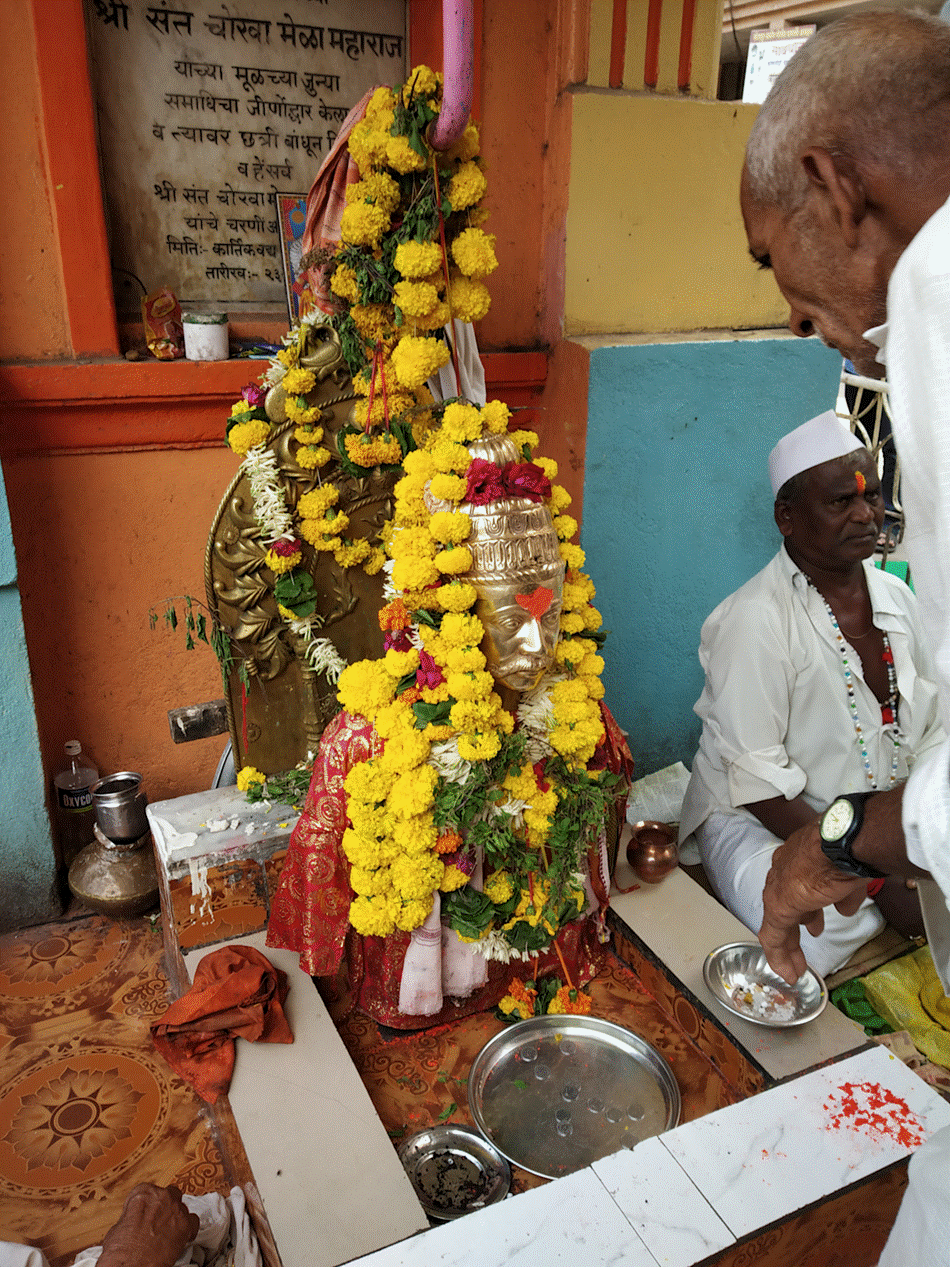
Samadhi of Sant Chokhamela at Pandharpur adorned with flowers and traditional offerings.
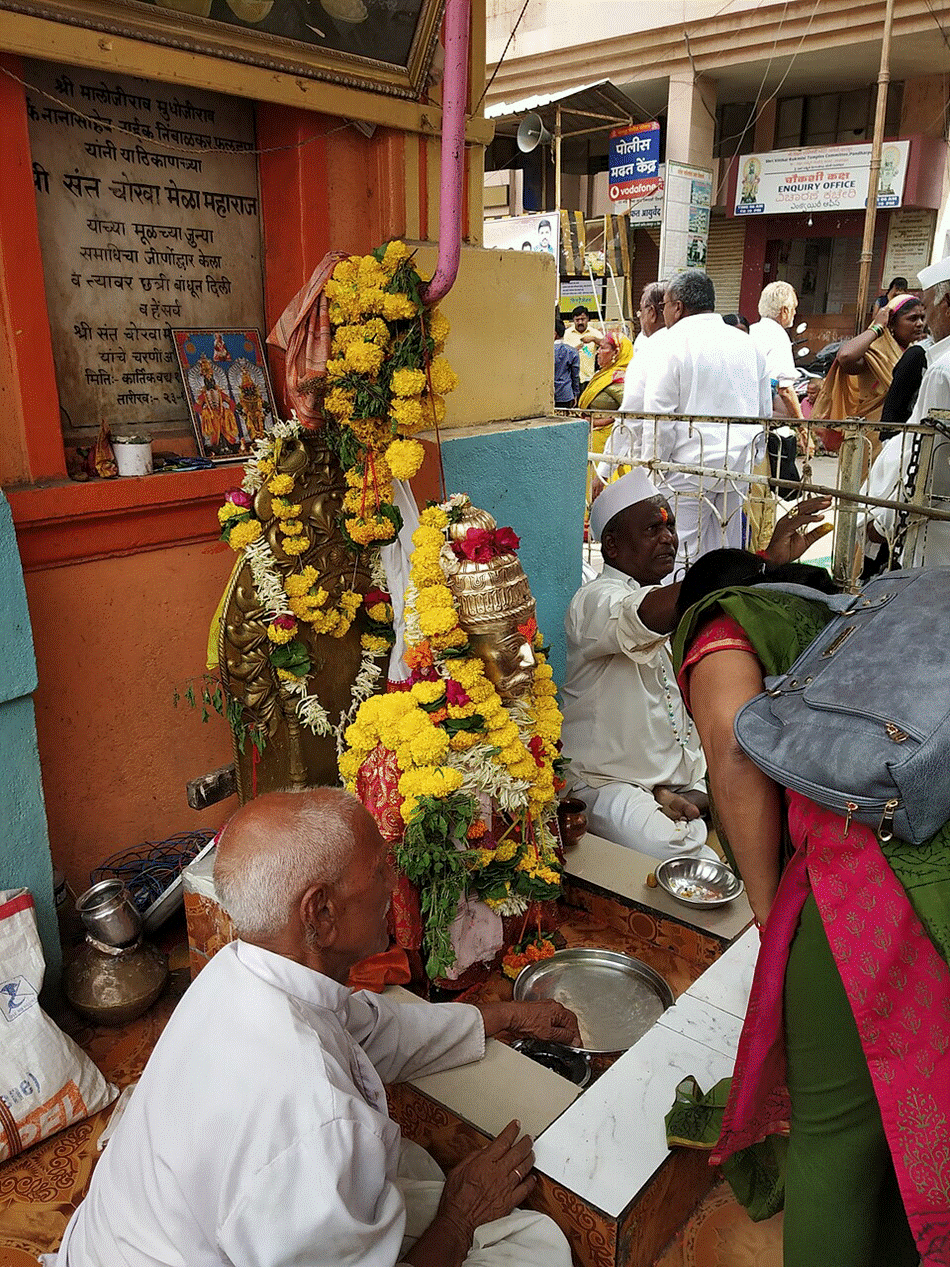
Samadhi shrine of Saint Chokhamela at Pandharpur decorated with garlands and visited by devotees.
Theological Contributions and Spiritual Innovation
Challenging Orthodox Hindu Theology
Chokhamela’s theological contributions to Hindu thought represent some of the most radical innovations in medieval Indian religious discourse, particularly in his challenges to orthodox concepts of purity, pollution, and spiritual hierarchy. His famous question “Can anyone be beyond pollution?” directly confronted the fundamental categories upon which caste discrimination was justified, suggesting that the very concept of ritual pollution was philosophically unsound. This theological critique preceded by centuries the more systematic challenges to purity concepts that would emerge in modern reform movements. [16][18][19][20]
His reinterpretation of karma doctrine was equally revolutionary, complicating orthodox explanations that justified present suffering through past-life transgressions. While occasionally referencing karmic principles, Chokhamela’s overall theological framework emphasized the immediate transformative power of devotion over karmic limitations. His poetry suggested that sincere bhakti could transcend karmic consequences, effectively democratizing spiritual liberation by making it accessible through devotional practice rather than ritual performance or caste status. [18][19][20][16]
The theological implications of Chokhamela’s work extended to fundamental questions about divine nature and accessibility. His poetry presented a deity who was intimately involved in the lives of marginalized people, participating in their daily labor and sharing their social experiences. This theological framework challenged brahminical conceptions of divine transcendence that maintained hierarchical distance between deity and devotee, particularly devotees from “polluted” castes. [27][17][19][32][18]
Integration of Buddhist and Bhakti Elements
Scholarly analysis of Chokhamela’s theological framework reveals sophisticated integration of Buddhist and bhakti philosophical elements, creating a syncretic approach that drew from multiple traditions while maintaining devotional focus. His emphasis on impermanence and the critique of scriptural authority in Abhanga 2825, where he declares “The Vedas and the shastras polluted; the puranas inauspicious,” reflects Buddhist influences on his religious thinking. This integration was not merely eclectic but represented a coherent theological position that used Buddhist logic to support bhakti conclusions. [18][19]
The influence of Buddhist thought in Chokhamela’s work may reflect the historical presence of Buddhist communities in Maharashtra and the lingering impact of Buddhist egalitarian ideals on regional religious culture. His scientific temper in approaching questions of pollution and social hierarchy demonstrated rational approaches to religious questions that resonated with Buddhist analytical traditions. This rational element in his devotional poetry created space for logical critique of social practices even within emotional expressions of spiritual longing. [16][19][18]
The synthesis of Buddhist rationality with bhakti emotionalism in Chokhamela’s work created a distinctive theological position that influenced later developments in Maharashtra religious thought. His ability to combine logical analysis of social problems with passionate devotional expression provided a model that later saints and social reformers would adapt to their own contexts. This theological flexibility allowed his ideas to remain relevant across different historical periods and political movements. [19][18]
Social and Economic Analysis
Critique of Feudal Relations
Chokhamela’s poetry provides valuable insight into the economic relationships that sustained caste hierarchy in medieval Maharashtra, offering one of the earliest literary analyses of how social oppression functioned through economic exploitation. His personal experience as an agricultural laborer and farm guard informed his understanding of how caste status determined access to economic opportunities and shaped relationships between landowners and workers. This experiential knowledge allowed him to articulate connections between social discrimination and economic marginalization with unprecedented clarity. [4][17][22][18]
His treatment of labor dignity in devotional poetry represented a revolutionary revaluation of work traditionally considered degrading. By associating divine presence with manual labor and domestic chores, Chokhamela challenged economic hierarchies that devalued physical work while privileging intellectual and ritual activities. This theological innovation had significant economic implications, suggesting that the labor performed by marginalized communities was spiritually valuable and deserving of social recognition. [17][18][19]
The economic analysis embedded in Chokhamela’s work also addressed questions of resource distribution and social justice. His poems about requesting leftover food and seeking basic sustenance highlighted how caste discrimination created material deprivation that went beyond symbolic exclusion. By connecting spiritual themes with economic realities, his poetry demonstrated how religious and material oppression reinforced each other in maintaining systems of social control. [3][6][18][17]
Understanding Medieval Maharashtra Society
Chokhamela’s literary work provides historians with unique primary source material for understanding social relations in 14th-century Maharashtra from the perspective of marginalized communities. His detailed descriptions of daily life, work patterns, and social interactions offer insights into historical experiences that are rarely documented in formal historical records. This documentary value of his poetry extends beyond its spiritual significance to provide sociological evidence about medieval Indian society. [16][17][18]
His observations about temple practices, ritual hierarchies, and religious authority structures illuminate how brahminical power functioned in practical social contexts. The contrast between official religious ideologies and their implementation in daily community life emerges clearly through his experiential accounts of discrimination and exclusion. These firsthand perspectives provide crucial counter-narratives to elite historical sources that often minimized or justified social oppression. [22][18][16]
The geographical specificity of Chokhamela’s work—his references to particular places, local customs, and regional practices—also contributes to understanding medieval Maharashtra’s cultural landscape. His movement between villages, work in different occupational contexts, and participation in various community activities created a comprehensive view of regional society that includes perspectives often absent from historical documentation. This ethnographic dimension of his poetry makes it valuable for understanding how broad social structures affected individual lives and local communities. [1][4][17][18][16]
Conclusion
Sant Chokhamela’s extraordinary life and literary legacy represent one of the most significant contributions to Indian spiritual and social thought, establishing foundations that continue to influence contemporary discussions about caste, devotion, and social justice. His unique position as both a marginalized untouchable and a revered saint created a powerful platform for challenging orthodox religious and social hierarchies while maintaining deep spiritual commitment. Through his profound devotional poetry, he demonstrated that authentic spiritual expression could emerge from any social position and that divine love transcended human-constructed boundaries of purity and pollution. [1][16][25][18][19][32]
The theological innovations embedded in Chokhamela’s abhangas—particularly his radical reinterpretation of divine accessibility, his critique of ritual hierarchies, and his integration of social consciousness with spiritual devotion—created new possibilities for Indian religious thought that influenced centuries of subsequent development. His work bridged the gap between personal spiritual experience and collective social transformation, showing how individual devotional practice could become a form of resistance against oppressive structures. This integration of spirituality and social critique provided a model that later movements, from medieval bhakti traditions to modern Downtrodden (Dalit) literature, would adapt and develop in their own contexts. [16][25][18][19][32]
The enduring relevance of Chokhamela’s message lies in his demonstration that human dignity and spiritual worth cannot be determined by birth, social status, or external circumstances. His life exemplified the possibility of maintaining spiritual integrity and social consciousness even under conditions of extreme oppression, providing inspiration for marginalized communities seeking both religious meaning and social transformation. As contemporary India continues to grapple with questions of caste discrimination, social equality, and spiritual authenticity, Chokhamela’s legacy offers both historical perspective and ongoing guidance for creating more inclusive and just forms of religious and social life. His samadhi at Pandharpur, where pilgrims of all castes must pass to reach the deity, remains a powerful symbol of his ultimate victory over the exclusions he faced in life—transforming the untouchable saint into an eternal guardian of spiritual equality and divine love. [7][23][25][18][19][20][16]
- https://en.wikipedia.org/wiki/Chokhamela
- https://testbook.com/question-answer/which-of-the-following-statements-about-chokhamela–628c3730d8f0981e0ebe67ef
- https://scroll.in/article/948368/the-art-of-resistance-chokhamelas-songs-spoke-of-the-dalit-experience-as-part-of-bhakti-movement
- http://all-india-report.blogspot.com/2013/09/saint-chokhamela.html
- https://www.taylorfrancis.com/chapters/mono/10.4324/9781003332152-22/chokhamela-untouchable-saint-govinda-pillai
- http://swaravanshi.blogspot.com/2012/04/johar-maibaap-sant-chokhamela-marathi.html
- https://en.bharatpedia.org/wiki/Chokhamela
- https://en.wikipedia.org/wiki/Mahar
- http://saintpoets.blogspot.com
- https://www.ambedkaritetoday.com/2019/10/vithoba-saint-chokhamela-marathi-dalit-poet.html
- http://andhakudi.blogspot.com/2025/07/the-divine-wait-chokhamelas-abhang-and.html
- https://chandrakantkmhatre.files.wordpress.com/2015/06/ohpcm-preview-1.pdf
- https://mr.wikipedia.org/wiki/चोखामेळा
- https://vivekavani.com/sant-soyarabai/
- https://en.wikipedia.org/wiki/Karmamela
- https://sabrangindia.in/chokhamelas-bhakti-the-past-transforms-into-a-radical-present/
- https://www.newsclick.in/chokhamelas-bhakti-past-transforms-radical-present
- https://www.newsclick.in/in-chokhamela-bhakti-past-transforms-radical-present
- http://uprtou.ac.in/other_pdf/19_07_2024_MAEN_118.pdf
- https://www.academia.edu/34284552/_I_am_the_Mahar_of_your_Mahars_Cokhāmelā_The_Modern_Dalit_Movement_and_Dalit_Christian_Theology
- https://dde.manuu.edu.in/sites/default/files/DDE/DDE-SelfLearnmaterial/MA-English-4th-Semester/Dalit-Literature-An-Introduction.pdf
- http://akwrite.blogspot.com/2019/12/margazhi-blogotsavam-day-6-chokha-mela.html
- https://alchetron.com/Chokhamela
- https://www.nirvahan.com/2023/
- https://www.scribd.com/document/862522126/Dalit-Change-Chokhamela-and-Ravidas
- https://beyondheadlines.in/2020/07/saint-namdev-and-anti-caste-movement-in-medieval-india/
- https://en.wikipedia.org/wiki/Namdev
- https://www.instagram.com/p/CUtkM_MpbAO/?hl=en
- http://medievalsaint.blogspot.com/2014/02/saint-namdev.html
- https://organiser.org/2021/11/15/17053/bharat/remembering-sant-namdev/
- https://www.vedantu.com/question-answer/the-varkari-sect-introduced-the-glorious-class-8-social-science-cbse-60adc9f030cccf5f3f3b38ed
- https://en.wikipedia.org/wiki/Warkari
- https://varakari.org/varakari-tradition/
- https://jogeshwarimisal.com/the-varkari-tradition-and-jogeshwari-misal-a-journey-of-devotion/
- https://www.scribd.com/document/732691020/99notes-in-Varkari-Movement-Maharashtras-Spiritual-Tradition
- https://testbook.com/mpsc-preparation/bhakti-movement-in-maharashtra
- https://m.thewire.in/article/culture/ashadhi-ekadashi-chokhoba-vitthal-pandharpur-abhang-raga
- https://www.youtube.com/watch?v=03aTTRWLd9g
- https://saintpoets.wordpress.com/page/2/
- https://veterinaria.org/index.php/REDVET/article/download/1798/1425/
- https://velivada.com/2020/05/02/the-value-of-a-man-is-axiomatic-self-evident-babasaheb-ambedkar/
- https://azimpremjiuniversity.edu.in/bhakti-republic-with-amit-basole/varkaris-on-the-path-to-pandharpur
- https://www.instagram.com/p/B91twX_hU5v/
- http://medievalsaint.blogspot.com/2014/03/saint-chokhamela.html
- https://deshwale.com/sant-chokhamela-biography-teachings/
- https://archive.org/details/Stories_On_Guru_Disciple_Relationship
- https://www.exoticindiaart.com/book/details/guru-disciple-relationship-bengali-mzr313/
- https://velivada.com/2024/01/29/dr-b-r-ambedkar-the-true-feminist-of-india/
- https://aarhat.com/download-article/2504/
- https://theambedkarianchronicle.in/archives/spiritual-in-ambedkar-from-margin-to-mahaparinirvana
- https://lohiatoday.com/wp-content/uploads/2018/09/ambedkar-v01.pdf
- https://en.wikipedia.org/wiki/Dalit_literature
- https://www.britannica.com/topic/Varakari-Panth
- https://ppl-ai-code-interpreter-files.s3.amazonaws.com/web/direct-files/ecdfcd60142bf024c93e902401ae1de4/7ef965d6-72ed-499a-bc2b-69f9eb1e7d59/ad8e2155.csv
- https://ppl-ai-code-interpreter-files.s3.amazonaws.com/web/direct-files/ecdfcd60142bf024c93e902401ae1de4/7ef965d6-72ed-499a-bc2b-69f9eb1e7d59/ea7a86f1.csv
- https://ppl-ai-code-interpreter-files.s3.amazonaws.com/web/direct-files/ecdfcd60142bf024c93e902401ae1de4/7ef965d6-72ed-499a-bc2b-69f9eb1e7d59/5aa8de2d.csv










